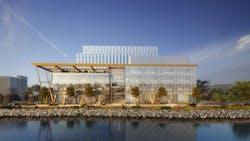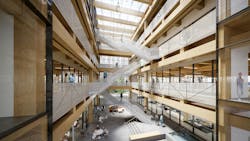Practical Insights for Implementing Regenerative Design
As the built environment evolves to address pressing global climate challenges, regenerative design is emerging as a transformative approach that extends beyond traditional sustainability. Unlike conventional design models focused on minimizing negative impacts, this design approach aims to actively restore and rejuvenate the natural systems with which buildings interact.
Through a commitment to these practices, we strive to foster a mindset of co-evolution with nature, enabling buildings to sustain and actively enhance their surrounding ecosystems and communities. For architects, facility managers, and construction professionals, adopting these principles means creating spaces that contribute positively to the environment and support long-term ecological health.
Understanding the Evolution of Building Standards
In the past, traditional sustainable building standards primarily focused on minimizing harm to the planet by reducing energy consumption, lowering emissions, and improving waste management. While these practices have brought important environmental benefits, they also need to fully address the long-term impact buildings have on their surroundings. Sustainability alone aims to minimize the ecological footprint and use no more resources than can be regenerated; meanwhile, regenerative design takes sustainability a step further by aiming to not only repair damage but also to actively restore and improve natural systems, giving back to the environment and society in the process. Instead of merely reducing our footprint, this approach encourages us to create lasting, positive impacts for future generations.
Regenerative Design in Practice
At the heart of this approach is the integration of advanced technologies and materials that support regeneration and resilience. The use of AI and 3D printing, for example, has gained significant attention as it allows for the creation of structures that are not only efficient but adaptable and capable of evolving in response to changing environmental conditions.
In addition to these technologies, materials play a crucial role. Materials such as fast-growing wood, hemp, bark, cork, straw, and bamboo, along with innovations like biochar and mineralized CO2 in zero-carbon cement and gypsum, contribute to reducing atmospheric emissions and diverting harmful materials from landfills. These materials are carefully selected not just for their durability but for their ability to contribute to the lifecycle of the building, often incorporating elements that mimic natural processes.
Despite these challenges, innovative solutions are emerging. A pilot program in Maine, for instance, is exploring the integration of regenerative design principles in hospitals, creating spaces that promote healing through connections with nature. Another example is the urban “AGRIHOOD” in Detroit, which illustrates methods for improving food security, cost-effective and scalable solutions for blight removal, and advancements in blue and green infrastructure.
Regenerative Design Approach to Key Sustainable Design Elements
- Holistic Systems Thinking: Regenerative design views buildings and landscapes as integral parts of larger ecosystems, emphasizing the optimization of interactions between natural, built, and human systems.
- Positive Impact: Instead of merely minimizing negative impacts, regenerative design aims to create positive outcomes for the environment, society, and the economy, such as improving ecological health and community well-being.
- Restoration and Enhancement: This principle focuses on restoring and enhancing natural systems, regenerating ecosystems, improving soil health, and increasing biodiversity.
- Adaptability and Resilience: Buildings and landscapes are designed to be adaptable to changing conditions, including climate change and evolving social needs, emphasizing flexibility and the ability to evolve.
- Closed-Loop Systems: Regenerative design seeks closed-loop systems where waste is minimized and resources are continuously cycled back into use, including repurposing materials and reducing reliance on non-renewable resources.
- Local Context and Materials: Designs are tailored to local environmental conditions and cultural contexts, using locally sourced materials and integrating solutions that respect and enhance the local environment and community.
- Human and Ecological Health: Prioritizes the health and wellbeing of both people and ecosystems, improving indoor air quality, creating healthy living environments, and ensuring projects contribute positively to local ecosystems.
- Integrated Design Process: Involves a collaborative, multidisciplinary approach with architects, engineers, ecologists, and community members working together to develop solutions addressing complex challenges.
- Continuous Evaluation, Learning, and Improvement: Emphasizes iterative processes with ongoing monitoring and evaluation to refine and improve practices, learning from both successes and failures.
- Effective Decision-Making: Focuses on making informed and strategic decisions that align with regenerative principles, ensuring that choices contribute to long-term environmental and social benefits.
Real-World Applications and Metrics
The effectiveness of regenerative design can be measured using various metrics, including Energy Usage Intensity (EUI) and the total carbon impact of a building. EUI helps in evaluating the performance of buildings over time, ensuring that they meet the desired environmental and operational goals.
The second metric provides a more comprehensive view as it assesses a building's long-term carbon impact, ensuring alignment with regenerative design principles. One component of this is embodied carbon, which was addressed in an in-depth study comparing Mass Timber design with conventional steel structures, applying the same performance criteria for top-tier life science buildings. The study revealed that Mass Timber could reduce embodied carbon by as much as 40% while maintaining structural integrity.
What’s Next for Regenerative Design?
The future of regenerative design is set to be shaped by ongoing innovations in technology and materials. Advancements such as AI and 3D printing are pushing the boundaries of what’s possible, enabling more precise and adaptable building designs. These technologies and advancements, along with emerging materials and construction methods, are enhancing the potential of buildings setting new standards for sustainability, and even reversing the grid.
As the design philosophy continues to evolve, it represents a shift from the traditional building practices we were once accustomed to. By emphasizing the importance of restoration and active enhancement of natural systems in design, we can develop buildings that not only meet current needs but also contribute positively to the environment and society. For facilities managers, architects, and construction professionals, adopting these principles is essential for creating resilient environments. The industry must embrace this shift, continuously innovating and adapting to realize the full potential of regenerative design.
About the Author
Sadaf Jafari
Sadaf Jafari is Director of Sustainable Design at SGA.

